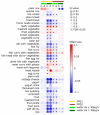Associations between Diet and Toenail Arsenic Concentration among Pregnant Women in Bangladesh: A Prospective Study
- PMID: 28441747
- PMCID: PMC5409759
- DOI: 10.3390/nu9040420
Associations between Diet and Toenail Arsenic Concentration among Pregnant Women in Bangladesh: A Prospective Study
Abstract
This prospective study evaluated the relationship between long-term dietary habits and total arsenic (As) concentration in toenail clippings in a cohort of 1616 pregnant women in the Bangladeshi administrative regions of Sirajdikhan and Pabna Sadar. Diet was assessed at Gestation Week 28 and at Postpartum Month 1, using a locally-validated dish-based semi-quantitative food-frequency questionnaire. Toenail As concentration was analyzed by microwave-assisted acid digestion and inductively coupled plasma mass spectrometry. Associations between natural log-transformed consumption of individual food items and temporally matched natural log-transformed toenail As concentration were quantified using general linear models that accounted for As concentration in the primary drinking water source and other potential confounders. The analysis was stratified by As in drinking water (≤50 μg/L versus >50 μg/L) and the time of dietary assessment (Gestation Week 28 versus Postpartum Week 1). Interestingly, toenail As was not significantly associated with consumption of plain rice as hypothesized. However, toenail As was positively associated with consumption of several vegetable, fish and meat items and was negatively associated with consumption of rice, cereal, fruits, and milk based food items. Further studies in pregnant women are needed to compare As metabolism at different levels of As exposure and the interaction between dietary composition and As absorption.
Keywords: Bangladesh; arsenic exposure; dietary assessment; food frequency questionnaire; pregnancy.
Conflict of interest statement
The authors declare no conflict of interest. The founding sponsors had no role in the design of the study; in the collection, analyses, or interpretation of data; in the writing of the manuscript, and in the decision to publish the results.
Figures


References
-
- WHO Exposure to Arsenic: A Major Public Health Concern. [(accessed on 15 April 2015)]; Available online: http://www.who.int/ipcs/assessment/public_health/arsenic/en/
-
- Agency for Toxic Substances and Disease Registry (ATSDR) Agency for Toxic Substances and Disease Registry: Arsenic Toxicity: Environmental Alert. ATSDR; Atlanta, GA, USA: 2000.
MeSH terms
Substances
Grants and funding
LinkOut - more resources
Full Text Sources
Other Literature Sources
Medical
Research Materials

